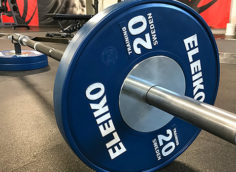For better gains, try to match the resistance profile of an exercise to the strength curve of the target muscle. If you do, you can stimulate the target muscle across every inch of every rep.
Achieving this is actually pretty simple on extension exercises, like squats and presses. The use of accommodating resistance gets the job done. Simply adding bands or chains to the lift means you can very closely match your strength curve.
On isolation exercises with free weights, things are a bit more complicated, but by manipulating your body position it can be achieved fairly easily. Pulling exercises are more problematic.
The Problem With Pulling Moves
With a pulling exercise, you have a descending strength curve. Most exercises used to train the pulling muscles have the opposite. For example, during a single-arm row the mechanics of the lift make it harder as you lift because the lever arm increases throughout. So, you're limited by what you can lift at the weakest point.
This means a large portion of the lift is very easy and only as you reach peak contraction is it truly difficult. Moving your body position to solve the issue doesn't work, and adding bands or chains actually magnifies the issue.
The Solution
Use the double-barrel technique: perform targeted partial reps to fully challenge the muscles. Specifically, do quarter reps at the top and bottom of the lift. To get the most from these quarter reps, you need to do them in a logical sequence.
The peak contraction is the weakest part of the lift, so when you're fresh you target that. Then, as fatigue sets in, you transition to focus on the strongest part of the lift (the start).
- Row back for a normal rep, lower the weight a quarter of the way down, then row it back to peak contraction. This hammers the fully shortened range when you're freshest.
- As fatigue kicks in you switch your quarter reps to the beginning of the movement where you're strongest.
Think of it almost like a mechanical drop set within one set. While you may be completely fatigued in the final quarter of the range, you still have plenty left for the earlier portion of the lift. By doing a quarter rep along with every normal rep you can fully fatigue this range too.
Note: It might not be possible to hit a full range of motion and reach the peak contraction position at the end when you're doing your starting range for one and a quarter. This is fine. The whole point at this stage is to challenge the starting portion and that's exactly what you'll be doing.
Oh, and that isn't an excuse to half-ass things. Still try to go full ROM, just don't beat yourself up if you can't manage it.




